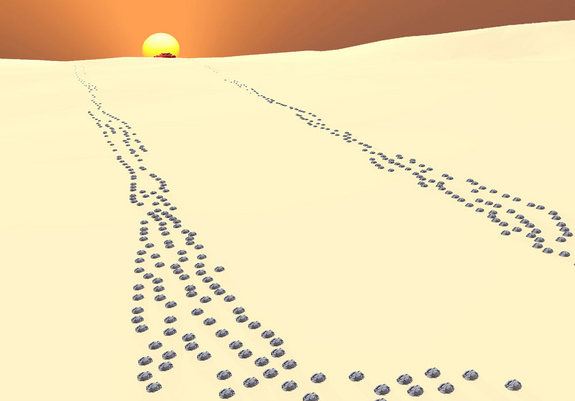
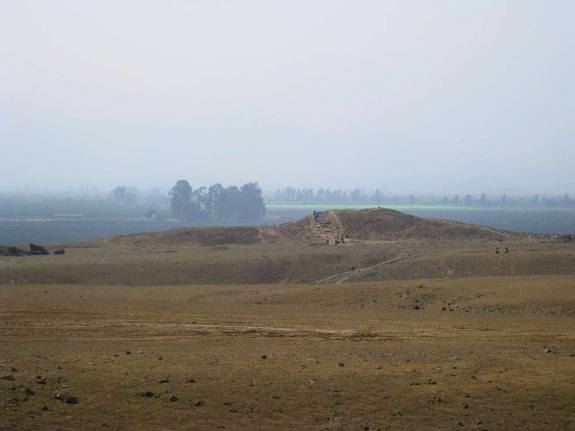
Dee Finney's blog
start date July 20, 2011
today's date May 21, 2013
page 500
TOPIC: PYRAMID AND FOOTPRINTS IN SANDSTONE IN PERU
THIS IS SUPPOSEDLY 1.2 BILLION YEAR OLD STRATA
WHO WOULD BELIEVE MAN WAS ALIVE THEN - ESPECIALLY IN PERU?
THAT'S NOT WHAT OUR SCIENCE NOR THE BIBLE WOULD HAVE US BELIEVE
ARCHEAOLOGISTS ARE GOING TO PROVE BOTH SCIENCE AND THE BIBLE WRONG !!!
Stunning Astronomical Alignment Found at Peru Pyramid
By Owen Jarus, LiveScience Contributor | LiveScience.com – Mon, May 6, 2013
An ancient astronomical alignment in southern Peru has been discovered by researchers between a pyramid, two stone lines and the setting sun during the winter solstice. During the solstice, hundreds of years ago, the three would have lined up to frame the pyramid in light.
The two stone lines, called geoglyphs, are located about 1.2 miles (2 kilometers) east-southeast from the pyramid. They run for about 1,640 feet (500 meters), and researchers say the lines were "positioned in such a way as to frame the pyramid as one descended down the valley from the highlands."
Using astronomical software and 3D modeling, the researchers determined that a remarkable event would have occurred during the time of the winter solstice. [See Images of the Pyramid and Solstice Alignment]
"When viewed in 3D models, these lines appear to converge at a point beyond the horizon and frame not only the site of Cerro del Gentil [where the pyramid is], but also the setting sun during the time of the winter solstice," the research team wrote in a poster presentation given recently at the Society for American Archaeology annual meeting in Honolulu.


The flat-topped pyramid at Cerro del Gentil stands 16 feet (5 meters) tall and is made out of adobe. Pyramid artifacts found nearby the pyramid include textiles, shells and ceramics. A settlement nearby contained around 1,000 people.
Thus someone viewing the sunset from these lines during the winter solstice would have seen the sun setting directly behind, or sinking into, the adobe pyramid," they write. "Thus the pyramid and the linear geoglyph constitute part of a single architectural complex, with potential cosmological significance, that ritualized the entire pampa landscape." (The word "pampa" stands for plain.)
The flattop pyramid is 16 feet (5 m) high and was built sometime between 600 B.C. and 50 B.C., being reoccupied somewhere between A.D. 200 and 400. Finds near the pyramid include textiles, shells and ceramics. The stone lines were constructed at some point between 500 B.C. and A.D. 400.
Lines, settlements and pyramids
But this discovery is just the tip of the proverbial iceberg. Researchers have found about 50 of these stone lines so far in a flat, dry area near the pyramid. The longest of the lines runs for nearly a mile (about 1,500 m). These lines are straight and made out of rock, unlike the Nazca Lines in southern Peru which were etched into the earth by removing the topsoil and include depictions of animals and plants. [Image Gallery: The Nazca Lines of Russia]
Interspersed with these lines, researchers have also found more than 200 cairns (rock piles). The biggest of these cairns is about 50 feet (15 m) in diameter. Cairns can be found throughout the world and sometimes contain human burials, the examples found here, however, do not.
The stone lines and cairns appear to be connected with nearby settlements and their pyramids. There are four ancient settlements close to them, two of which have large pyramids and one that has a mound. The settlements would have supported populations in the high hundreds or just over 1,000.
"Many of the lines do lead to the pyramids; most lead to within the area of the pyramid," said Charles Stanish, a professor at UCLA's Cotsen Institute of Archaeology, in an interview with LiveScience. "We did a statistical analysis, and it is statistically significant— it couldn't have been by random chance that they do cluster on these settlements," he said, noting that there are a few lines that don't lead to settlements.
Stanish said that the discovery of ancient lines leading to pyramids in Peru is important. "We have lines that run to pyramid complexes, and that's significant, because in the big Nazca pampa and in the Palpa pampa, we don't find that pattern as obvious." These two areas, Nazca and Palpa, contain lines, etched in earth, that depict various motifs, including animals and plants.
Future exploration
The team has only completed one field season at the site and will be heading back this summer to continue their work. They plan to excavate at the Cerro del Gentil pyramid and search for more stone lines.
"We're also going to do a systematic survey of a fairly large area to find all the other lines and all the other settlements and features," Stanish said. They also plan to dig test pits in structures associated with the lines to try to determine precisely when they were built.
One problem the team faces is that time is against them. "A lot of them [the stone lines] are being destroyed by construction," said Stanish, explaining that modern-day power and gas lines are being built in the area, jeopardizing the ancient stone lines that have stood for well over a millennia.
Follow us @livescience, Facebook & Google+. Original article on LiveScience.com.
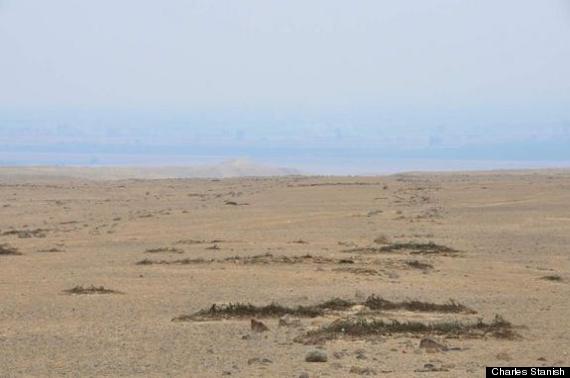
The flattop pyramid is 16 feet (5 m) high and was built sometime between 600 B.C. and 50 B.C., being reoccupied somewhere between A.D. 200 and 400. Finds near the pyramid include textiles, shells and ceramics. The stone lines were constructed at some point between 500 B.C. and A.D. 400.
Lines, settlements and pyramids
But this discovery is just the tip of the proverbial iceberg. Researchers have found about 50 of these stone lines so far in a flat, dry area near the pyramid. The longest of the lines runs for nearly a mile (about 1,500 m). These lines are straight and made out of rock, unlike the Nazca Lines in southern Peru which were etched into the earth by removing the topsoil and include depictions of animals and plants. [Image Gallery: The Nazca Lines of Russia]
Interspersed with these lines, researchers have also found more than 200 cairns (rock piles). The biggest of these cairns is about 50 feet (15 m) in diameter. Cairns can be found throughout the world and sometimes contain human burials, the examples found here, however, do not.
Researchers have found about 50 of these stone lines, the longest of which runs close to nearly 1 mile (1,500 meters). Many of these lines point to nearby settlements and their pyramids. The lines date to somewhere between 500 B.C. and A.D. 400.
The stone lines and cairns appear to be connected with nearby settlements and their pyramids. There are four ancient settlements close to them, two of which have large pyramids and one that has a mound. The settlements would have supported populations in the high hundreds or just over 1,000.
"Many of the lines do lead to the pyramids; most lead to within the area of the pyramid," said Charles Stanish, a professor at UCLA's Cotsen Institute of Archaeology, in an interview with LiveScience. "We did a statistical analysis, and it is statistically significant— it couldn't have been by random chance that they do cluster on these settlements," he said, noting that there are a few lines that don't lead to settlements.
Stanish said that the discovery of ancient lines leading to pyramids in Peru is important. "We have lines that run to pyramid complexes, and that's significant, because in the big Nazca pampa and in the Palpa pampa, we don't find that pattern as obvious." These two areas, Nazca and Palpa, contain lines, etched in earth, that depict various motifs, including animals and plants.
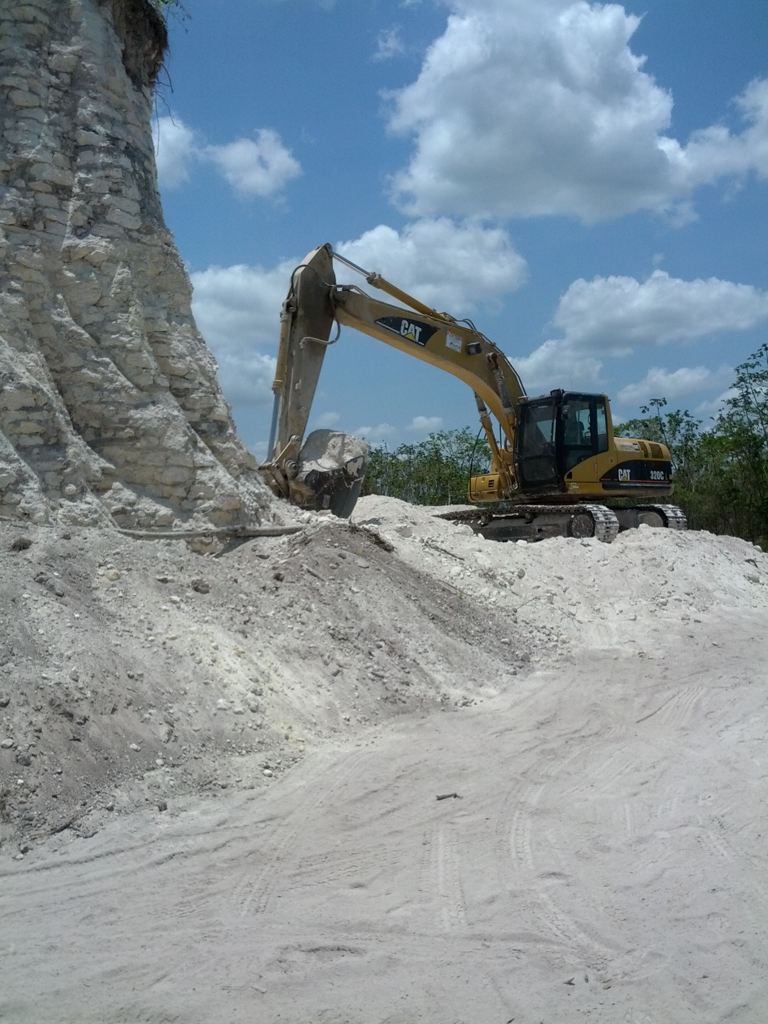
In this image released by Jaime Awe, head of the Belize Institute of Archaeology on Monday May 13, 2013, a backhoe claws away at the sloping sides of the Nohmul complex, one of Belize's largest Mayan pyramids on May 10, 2013 in northern Belize. A construction company has essentially destroyed one of Belize's largest Mayan pyramids with backhoes and bulldozers to extract crushed rock for a road-building project, authorities announced on Monday. (AP Photo/Jaime Awe) The owner of the property allowed the bulldozer to destroy this structure.


The government said Tuesday it is pursuing a "vigorous" investigation into a road-building company's near destruction of one of the largest Mayan pyramids in Belize.
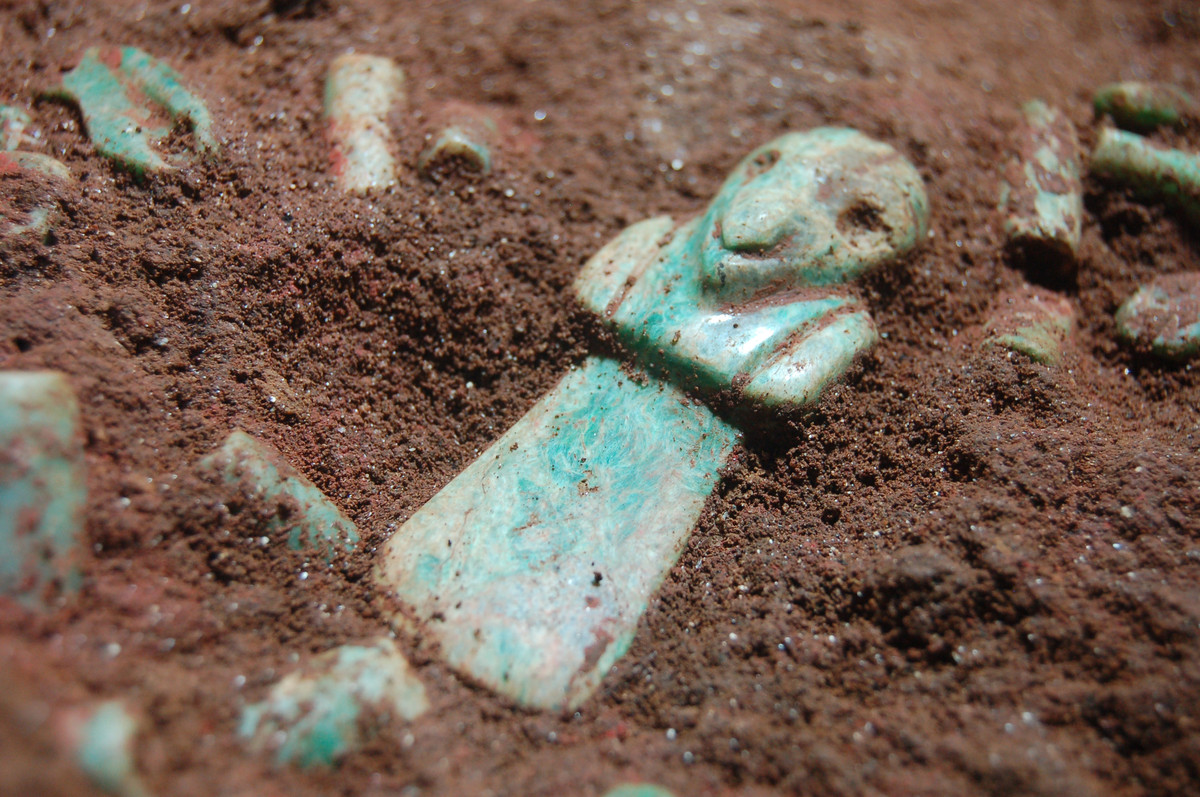
CARAL PERU
Caral, or Caral-Supe, was a large settlement in the Supe Valley, near Supe, Barranca province, Peru, some 200 km north of Lima. Caral is the most ancient city of the Americas, and is a well-studied site of the Caral civilization or Norte Chico civilization.
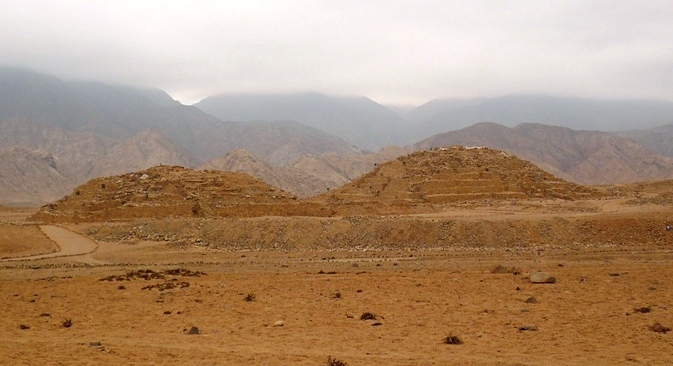
Caral was inhabited between roughly 2600 BCE and 2000 BCE,[1] enclosing an area of more than 60 hectares.[2] Caral was described by its excavators as the oldest urban center in the Americas, a claim that was later challenged as other ancient sites were found nearby. Accommodating more than 3,000 inhabitants, it is the best studied and one of the largest Norte Chico sites known.
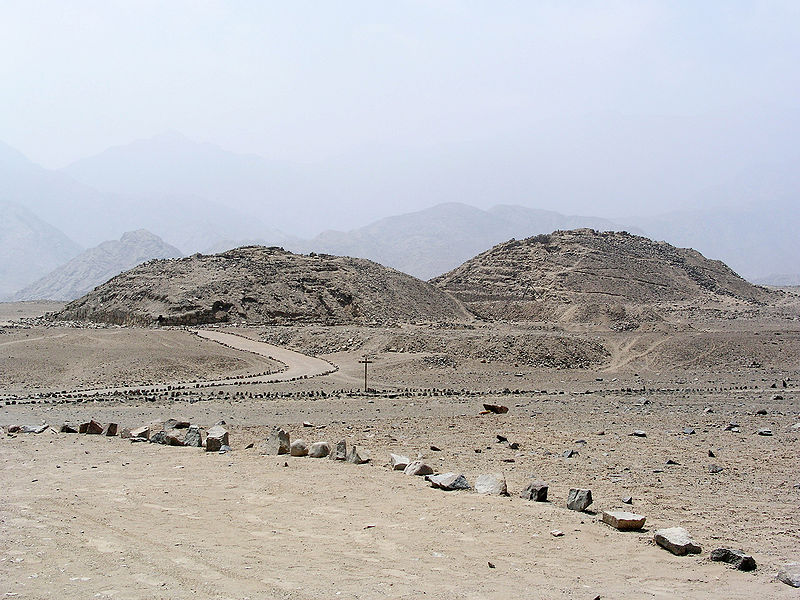
Paul Kosok discovered Caral in 1948, but it received little attention at the time because it appeared to lack many typical artifacts that were sought at archeological sites throughout the Andes at the time. Archaeologist Ruth Shady further explored the 5,000 year-old city of pyramids in the Peruvian desert, with its elaborate complex of temples, an amphitheater and ordinary houses.[3] The urban complex is spread out over 150 acres (607,000 m²) and contains plazas and residential buildings. Caral was a thriving metropolis at roughly the same time that Egypt's great pyramids were being built.
The main pyramid (Spanish: Pirámide Mayor) covers an area nearly the size of four football fields and is 60 feet (18 m) tall. Caral is the largest recorded site in the Andean region with dates older than 2000 BCE and appears to be the model for the urban design adopted by Andean civilizations that rose and fell over the span of four millennia. It is believed that Caral may answer questions about the origins of Andean civilizations and the development of the first cities.
Among the artifacts found at Caral are a knotted textile piece that the excavators have labeled a quipu. They argue that the artifact is evidence that the quipu record keeping system, a method involving knots tied in rope that was brought to perfection by the Inca, was older than any archaeologist had previously guessed. Evidence has emerged that the quipu may also have recorded logographic information in the same way writing does. Gary Urton has suggested that the quipus used a binary system which could record phonological or logographic data.
No trace of warfare has been found at Caral; no battlements, no weapons, no mutilated bodies. Shady's findings suggest it was a gentle society, built on commerce and pleasure. In one of the pyramids, they uncovered 32 flutes made of condor and pelican bones and 37 cornets of deer and llama bones. One find revealed the remains of a baby, wrapped and buried with a necklace made of stone beads.
Caral spawns 19 other pyramid complexes scattered across the 35 square mile (80 km²) area of the Supe Valley. The find of the quipu indicates that the later Inca civilization preserved some cultural continuity from the Caral civilization. The date of 2627 BCE is based on carbon dating reed and woven carrying bags that were found in situ. These bags were used to carry the stones that were used for the construction of the pyramids. The material is an excellent candidate for dating, thus allowing for a high precision. The site may date even earlier as samples from the oldest parts of the excavation have yet to be dated.[4] The town had a population of approximately 3000 people. But there are 19 other sites in the area (posted at Caral), allowing for a possible total population of 20,000 people for the Supe valley. All of these sites in the Supe valley share similarities with Caral. They had small platforms or stone circles. Shady (2001) believes that Caral was the focus of this civilization, which itself was part of an even vaster complex, trading with the coastal communities and the regions further inland – as far as the Amazon, if the depiction of monkeys is any indication.
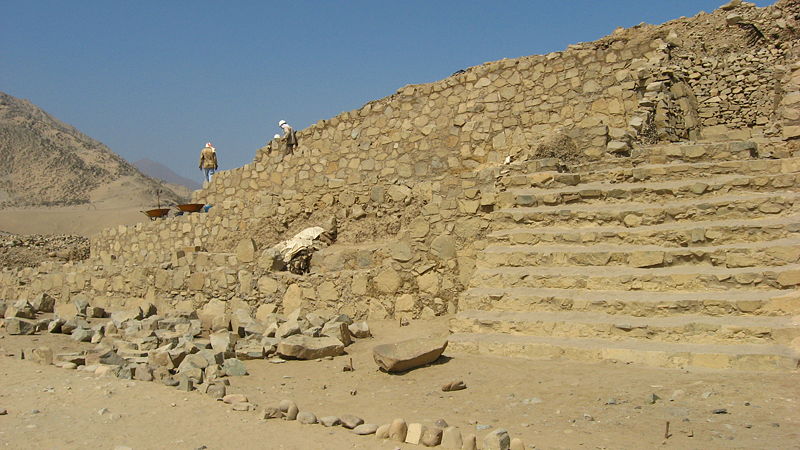



Another notable find on the site was a collection of musical instruments, including 37 cornets made of deer and llama bones and 33 flutes of unusual construction.[5] The flutes were radiocarbon dated to 2170±90 BCE.[3]
|
|
Wikimedia Commons has media related to: Caral-Supe |
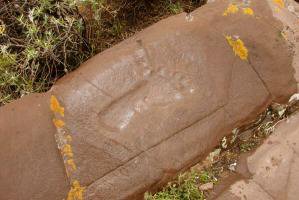
Investigators Jorge Miranda and Freddy Arce question the theories of human evolution with the anouncement of the discovery of a human footprint near Lake Titicaca which has an antiquity of between 5 and 15 million years. This would put man on the american continent millions of years before previously established dates and also before the existence of the Australopithecus, which lived in Africa around 4 million years ago.
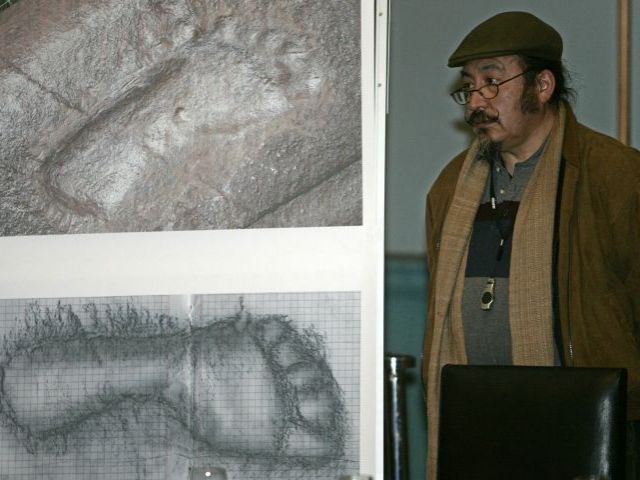
The surprising theory has been transferred to European experts, including a few not identified by the Bolivians, who have shown skepticism. "They asked us if we understood the significance of what we were proposing", commented Miranda. Also they have asked assistance from the chief of Egyptian antiquities, Zahi Hawass, who announced in August 2007 the discovery of a human footprint with an antiquity supposedly of two million years.
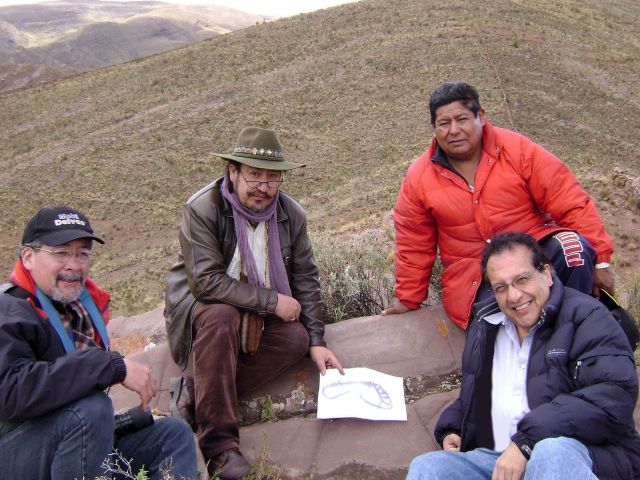
Jorge Miranda (b) and Freddy Arce (d) show the footprint in it's place of discovery, a stone which was found in the Aymaran locality of Sullkatiti, where it is a cult object because the inhabitants of the zone consider it to be a footprint of their ancestors, known as the footstep of the Inca.
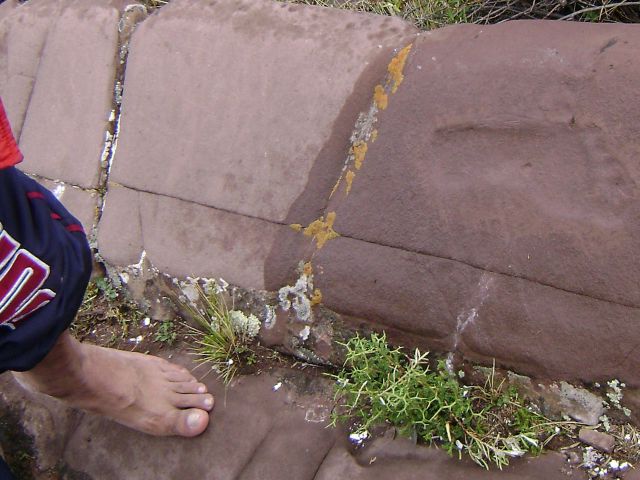
Bolivia gives the discovery a great imortance and the presentation, which has been under the charge of the investigators (in the photo, Jorge Miranda), took place in the Ministry of Exterior Relations, in La Paz. The human footprint found in the Altiplano will prove "the existence of other societies before ours", according to the experts.....
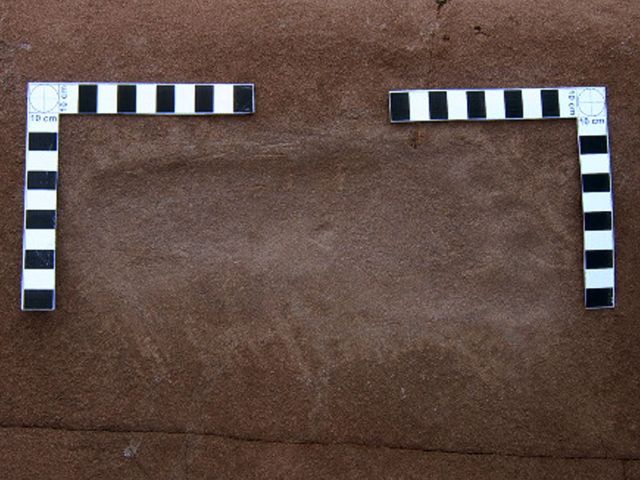
According to the data found by the investigators, the footprint measures 29.5 cm and belonged to a "body" of 1.7 metres high and around 70 kilos weight which, besides, walked upright for more than 5 million years.
Los investigadores Jorge Miranda y Freddy Arce cuestionan las teorías de la evolución del hombre con el anuncio del descubrimiento de una huella humana cerca del lago Titicaca que tendría una antigüedad de entre 5 y 15 millones de años. Esto situaría al hombre en el continente americano millones de años antes de lo establecido hasta ahora e incluso adelantaría la existencia del propio Australopithecus, que vivió en África hace unos 4 millones de años.
La sorprendente teoría ha sido trasladada a expertos europeos, a los que los científicos bolivianos no han identificado, que se han mostrado escépticos. "Nos preguntaron si sabíamos el significado de lo que estábamos proponiendo", ha comentado Miranda. También han pedido ayuda al responsable egipcio de antigüedades, Zahi Hawass, que anunció en agosto de 2007 el descubrimiento de una huella humana con una antigüedad supuesta de dos millones de años.
Jorge Miranda (b) y Freddy Arce (d) muestran la huella en el lugar de su descubrimiento, una roca que se encuentra cerca de la localidad aimara de Sullkatiti, donde es objeto de culto porque los habitantes de la zona consideran que es una huella de sus antepasados, popularmente conocida como la pisada del inca.
Bolivia otorga al descubrimiento una gran importancia ya que la presentación, que ha corrido a cargo de los dos investigadores (en la imagen, Jorge Miranda), ha tenido lugar en el ministerio de Relaciones Exteriores de Bolivia, en La Paz. La huella "humana" encontrada en el Altiplano probaría "la existencia de otras sociedades" anteriores a la actual, según los expertos.
Según los datos aportados por los investigadores, la huella mide 29,5 centímetros y pertenecería a un "cuerpo" de 1,70 metros de altura y unos 70 kilos de peso que, además, habría caminado erguido hace más de 5 millones de años.
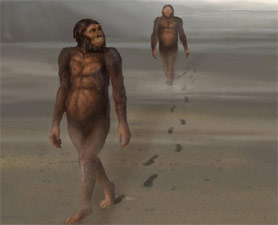
The earliest known human ancestor footprints show that individuals walked like we do 3.7 million years ago.
- A fully upright, two-footed gait likely evolved in Australopithecus afarensis, a tree-dwelling ancestor of living great apes and humans.
- Erect, bipedal walking offered many benefits, especially at a time when forest canopies started to break up.
The oldest known human ancestor footprints, dated to 3.7 million years ago, reveal that some of the earliest members of our family tree walked fully upright with feet similar to ours, according to new research.
The findings, published in the Journal of the Royal Society Interface, push back the date for upright walking in our ancestry by nearly 2 million years. That's because previous studies had concluded this trademark gait emerged in the genus Homo about 1.9 million years ago.
The 3.7 million-year-old footprint maker, likely a species called Australopithecus afarensis (of the "Lucy" fossil fame), walked in an even less ape-ish way than some humans do today.
Lead author Robin Crompton told Discovery News that "some healthy humans produce more 'ape like' footprints."
Crompton, a professor in the University of Liverpool's School of Biomedical Sciences, explained that many researchers believed loss of the "so-called mid-tarsal break," a flexing of the side midfoot, "distinguished humans from non-human apes." This flexing can contact the ground and leave behind a mark in footprints. But Crompton and his colleagues found that certain people today create such footprints, while some of the ancient prints were lacking the distinguishing feature.
The researchers made this determination after studying the ancient footprints, found at a site called Laetoli in Tanzania. At least one, or possibly two, individuals left behind the footprints as they walked through damp volcanic ash.
Detailed imaging, based on methods employed in functional brain imaging, yielded clear, three-dimensional views of the 11 intact prints in the Laetoli trail. The scientists then compared these ancient footprints with prints made by modern humans and other living great apes.
It's now known that the prehistoric walker moved at just over 3 1/2 feet per second.
"Walking was completely erect," Crompton said. "Push off was substantially by the big toe and a medial arch was present. There was no collapse of the lateral side of the foot, as has been recently suggested."
The probable walker, A. afarensis, is best known via a partial skeleton named "Lucy." Lucy and other members of her species are thought to have lived at least some of their time in trees. Since Lucy was already walking upright in a very human-way, the new study strengthens the theory that erect, two-footed walking evolved in a tree-living ancestor of living great apes and humans.
Crompton explained that this way of moving was "probably faster than quadrupedalism on the ground in an animal built like great apes are." It also may have "enhanced feeding from low branches or bushes."
Upright walking on two feet additionally could have helped with visual displays and showing aggression, he said. All of this may have happened as forest canopies broke up, forcing A. afarensis to leave its tree homes for a more terrestrial way of life.
Unlike modern humans, however, this species had short legs and a long body. When compared to other animals, we have just the opposite: relatively long legs and a short body.
Sarah Elton of the Hull York Medical School told Discovery News, "Although there have been heated disagreements over how to interpret the Laetoli footprints, this incredibly detailed and well thought-out study must surely help to put some of the debate to rest."
She continued, "I was surprised by such clear evidence for a very 'human-like' foot morphology and walking style, particularly the presence of a longitudinal arch, and 'toe off' when walking."
Elton added, "This strongly suggests that the makers of the footprints, although living over 3 million years ago, shared many features of their locomotion with us."
Crompton and his team next hope to determine when our ancestors first walked, or ran, over very long distances, enabling them to colonize the world.
.
|
AFRICAN LUCY compiled by Dee Finney |
.
|
|
2-20-04 - DREAM - IT'S STARTING - I was in Wisconsin, near Eau Claire.I went to visit my mother-in-law Lucy B. at her farmhouse. We were having a nice chat and then she told me that five of her sons had spun themselves to death to commit suicide the week before. There were no funerals for them because it was a sin to commit suicide. I thought that was atrocious. I went out for a walk and when I came back, the house was full of people who were all standing around crying. I was really puzzled, so I started asking people why everyone was crying. Nobody would tell me and that was making me angry. Finally I saw a priest standing in the midst of the crowd and he had tears in his eyes too. I said "Why is everyone standing around like somebody died? He didn't answer either, but more or less looked towards the other room. So I looked into the other room and there was my mother-in-law laying on her back with her eyes closed on top of the dining room table. People were sitting and standing around her seemingly dead body. I said, "Why didn't someone tell me? I was more angry than sad at that point. I went into the dining room to see her and she opened her eyes and started to sit up. She wasn't dead after all - just asleep. The people were stunned to see this. They stopped crying, but didn't know what to say. My mother-in-law was now sitting up and started singing and moving her hands strangely. I decided I would change the mood of the room by clapping for her and one by one the other people started clapping too because my mother-in-law was not only singing, she was dancing and changing shape. I didn't know what to make of it myself, but she was getting smaller and smaller and turning to a small dark-skinned woman. She ended up about a foot tall, and very thin and masculine appearing - like an African man. I just kept up the clapping and the cheering to keep the people in a happy mood, so they would think they were going crazy, seeing this weird thing happening. finally, she jumped off the table and ran outside. So, I followed her outside and I saw what a mess it was out there. The wind had blown sand around where it didn't belong and stuff was strewn everywhere. I said to some people, "Someone should just come in here with a bulldozer and move this dirt." So someone went to get a bulldozer and meanwhile, I saw sprouts of roses and rhubarb and other plants coming up through the dir and decided to replant them in a safe place and started doing that. The work wasn't done yet and I saw a huge grey demolition crane move into the area. I knew this wasn't a good thing and started yelling to the people, "It's starting! It's starting!" and started scrambling across the windblown sand to get out of there. I climbed up out of the dirt by a concrete wall and found a chunk of pure ice in the dirt. I was amazed by that and I ran down the street yelling, "It's starting! She went to the Baxter line in Africa." NOTE: I never identified the Baxter line in Africa. Many people investigated and wrote about hominids in Africa. |
.
.
.
|
From: http://www.life.uiuc.edu/animalbiology/biohistory/darwinsociety.html
|
|||||||||||||||||||||||||||||||||||||||||||||||||||||||||||||||||||||||||||||||||||||||||||||||||||||||||||||||||
|
Timeline of Early Humans: Chart from; http://www.geocities.com/Athens/Parthenon/3148/hominid1main.html The Australopithecines and their relatives. Homo habilis. All are early bipedal primates. Most are probably tool-users (as chimps are)
After this time (1.8 million years ago) hominids are found outside of Africa. Until recently, the earlist hominids outside of Africa were thought to be a mere 1-1.2 million years old. Now, some surprising finds from Europe and Java make us scratch our heads. For that story, see the next timeline, The Genus Homo. For another perspective on the same early hominid story, look at this brief table which represents the hominid finds by region. (all the regions are in Africa)
Photo from: http://vm.kemsu.ru/en/anthrop/shema.gif
|
|||||||||||||||||||||||||||||||||||||||||||||||||||||||||||||||||||||||||||||||||||||||||||||||||||||||||||||||||
| 1995 Africa's Eve is found to be an Adam By Graeme O'Neill LUCY, the most celebrated of all hominid fossils, is actually a male, : scientists announced this week after 25 years of research. Lucy's pelvic bones are far too small to accommodate a baby. And their orientation would have made it impossible for a baby to turn the corner from the uterus and line up with the home straight. Even in modern women, this sharp angle between the uterus and birth canal can make birth a tricky and painful affair. "Lucy is simply not built for giving birth," said Swiss anatomists Dr Martin Hausler and Dr Peter Schmid in the latest edition of the Journal of Human Evolution. It seems the African Eve, celebrated worldwide as the archetypal Dawn Mother, is actually an Adam 3.2 million years old. It is a quarter century since American scientist Donald Johansen and his French colleague Maurice Taieb discovered the remarkably preserved fossil skeleton in Ethiopia. It is of a small, short-legged hominid. The fossil is the oldest species of the proto- human genus Australopithecus- the finders named it Australopithecus afarensis and nick- named it Lucy after the character in a Beatles' song, Lucy In The Sky With Diamonds. Lucy's skeleton was about two-thirds complete - against the odds, the body was overlooked by scavenging hyenas and lions and was buried rapidly by volcanic ash in the Great Rift Valley before the elements could disperse the bones. Even some of the tiny bones from the hands and fingers were preserved but the right half of the pelvis was missing. The left side of the pelvis and part of the sacroiliac, which anchors the spinal column, was enough to tell anatomists that Lucy was no recent fugitive from the rainforests of east Africa, which were in retreat as the climate cooled and became drier. The legs were short in proportion to the trunk and the pelvis was relatively narrow. The femurs-the major bones in the top of the legs- projected almost straight down from their pelvic sockets, rather than angling in under the body's center of gravity. But they didn't splay outwards, in the manner of a chimpanzee or gorilla. The evidence was clear-Lucy-had walked upright. "Waddled" may be closer to the mark - the pelvic anatomy was not designed for the curving hips and fluid stride of latter- day great-granddaughters on a Paris catwalk. A widely published artist's impression of Lucy depicts the creature as dark-skinned and hairy with a protruding, ape-like face, large breasts (an evolutionary innovation in humans) and with a baby balanced on the right hip. But even for a prototype, whose architecture had yet to be refined and broadened to create a birth canal large enough to accommodate one of the boof-headed, large-brained babies of homo sapiens descendants, Lucy's pelvis seemed to be strangely shaped. For a quarter of a century anatomists have debated various mirror- image reconstructions of Lucy's incomplete pelvis and come to different conclusions. The pelvis is one of the most critical structures in human evolution. Not only is it crucial to an upright stance, as the fulcrum for the spine and legs; its lower bones and pubis, dictate the maximum size of the head and brain of any newborn baby. An enormous brain and head, in relation to body size, is the defining characteristic of modern human beings. Earlier research which showed measurements of Lucy's pelvic dimensions were unreliable because after millions of years the pelvis had become skewed. In their new reconstruction, Dr Hausler and Dr Schmid corrected for this distortion, then compared Lucy's pelvic architecture with that of one of the more recent descendants, a specimen of Australopithecus africanus from Sterkfontein Cave in South Africa, designated by the serial number S14. Lucy, designated by the serial number AL-288-I, is separated from S14 by almost the length of a continent and by several hundred thousand years of evolution. The interval was long enough for S14's species to develop the largest brain of any australopithecine around 580cc, compared with Lucy's 350cc brain. Dr Hausler and Dr Schmid say that in non-human primates, including chimpanzees and gorillas, the brain of newborns is about 42 per cent the capacity of the adult brain. But in newborn humans, it is only 29 per cent of the average adult capacity of about one litre-roughly 290cc. Much of the growth in a modern human baby's brain is delayed until after birth. This is why the bones in a human baby's skull remain open for several years after birth. This innovation, unique to humans, allows the adult human brain to become very large without exposing homo sapiens babies to the fatal prospect of being jammed inside the pelvis at birth. It still happens before caesarean births, natural selection ensured neither mother nor baby survived to pass on the trait. The Swiss researchers now propose that Lucy be renamed Lucifer, after the Roman god who brought light to the world after a long, dark night. (O'Neill G., "Africa's Eve is found to be an Adam", Sunday Times: Western Australia, 12 November 1995, p62) |
|||||||||||||||||||||||||||||||||||||||||||||||||||||||||||||||||||||||||||||||||||||||||||||||||||||||||||||||||
New models developed for understanding primate behavior can now be applied to the hard evidence of our ancestors to help us understand how our brains have enlarged three-fold since early hominid Lucy, four million years ago. Mitochondrial DNA (mtDNA) has become very relevant to paleoanthropology since the first Neandertal mtDNA sequence was discovered in 1997. Bryan Sykes' book The Seven Daughters of Eve is an excellent book for popular audiences which explains the science behind mtDNA and why it is so useful for investigating population histories. It also provides a good look at the way science is conducted, the conflicts and rivalries that occur, and contains diversions into fascinating topics such as the Iceman, golden hamsters, and the disappearance of the Russian royal family including Princess Anastasia. The book is somewhat Eurocentric, since most of Sykes' data (and the 'seven daughters') come from Europe, but a section at the back of the book discusses some of what is known about the worldwide distributions of mtDNA sequences.  Scientific
American has released a new special edition issue devoted to
paleoanthropology:
New Look at Human Evolution. It contains a number of updated
reprints of article about human evolution that have appeared in
Scientific American over the last decade or so. The articles cover
topics such as the Out of Africa and Multiregional models of human
evolution, recent fossil discoveries such as
Sahelanthropus and
Orrorin, neandertals, mtDNA, cannibalism, and the evolution
of bipedality and skin color. Scientific
American has released a new special edition issue devoted to
paleoanthropology:
New Look at Human Evolution. It contains a number of updated
reprints of article about human evolution that have appeared in
Scientific American over the last decade or so. The articles cover
topics such as the Out of Africa and Multiregional models of human
evolution, recent fossil discoveries such as
Sahelanthropus and
Orrorin, neandertals, mtDNA, cannibalism, and the evolution
of bipedality and skin color.Three fossil skulls discovered at Dmanisi in Georgia, in the ex-USSR, between 1999 and 2001 were a big surprise to the paleoanthropological community. Not only were they the oldest and most primitive hominid skulls ever found outside of Africa, in both brain size and anatomy they seemed intermediate between Homo habilis and Homo erectus fossils, and their finders classified them as a new species, Homo georgicus. Now a similar skull has apparently been found in Africa by Meave Leakey's team. This new skull, 1.55 million years old, was found in Kenya in 2000, and announced at the April 2003 meeting of the American Association of Physical Anthropologists. (Science, 300:893, 9 May 2003) The same report also noted that many of the scientists at the meeting were skeptical of the validity of Homo georgicus as a separate species. H. erectus expert Philip Rightmire is quoted as believing that the Dmanisi skulls are erectus. Finally, a fourth and more robust skull, along with some skeletal bones, has been discovered at Dmanisi. Tim White argues in a recent paper (Early hominids - diversity or distortion? Science 299:1994, March 28 2003) that maybe too many new fossil hominid species are being named. He lists 4 recently-named species as examples. Curiously, two of these are ones for which he was a coauthor. However, he takes particular aim at Kenyanthropus platyops, named in 2001 from a fossil skull found by Meave Leakey's team. White argues that it is so severely distorted that it cannot be confidently identified, and may just be a Kenyan variant of Australopithecus afarensis. White is, by all accounts, both widely recognized as a superb anatomist and feared for the sharpness of both his pen and his tongue. To see why, read this paper (A view on the science: Physical anthropology at the millennium, American Journal of Physical Anthropology 2000), which contains scathing verdicts on many claims from other scientists March 28, 2003: OH 65The latest fossil from Olduvai Gorge, OH 65, is a fossil upper jaw with part of the lower face. It was discovered in 1995, but was not made public until 2003 (Blumenschine et al. 2003, Science 299:1217-21 with a commentary by Phillip Tobias in the same issue). Based on its similarities with both OH 7 (the type specimen of H. habilis) and ER 1470, Blumenschine and his colleagues suggest that 1470 is therefore a member of habilis, making rudolfensis an invalid species.Naturally, nothing is ever that simple in paleoanthropology. Another scientist I spoke to thought that OH 65 differed from both OH 7 and another couple of fossils that may be rudolfensis jaws. Anatomist Bernard Wood, a major proponent of rudolfensis in the last decade, is another scientist unlikely to accept the demise of that species. So the conclusion of Blumenschine and his colleagues will certainly not go unchallenged. Tobias' commentary article notes that the number of hominid species and even genera has taken off in recent years. I had noticed the same phenomenon myself: since 1994, we have seen the naming of A. anamensis, Ar. ramidus, A. garhi, A. bahrelghazali, K. platyops, O. tugenensis, S. tchadensis, and H. antecessor. That's 8 new species, and 4 new genera, in less than a decade. A similar explosion of species and genera occurred in the first half of the 20th century. Scientists and discoverers of fossils cheerfully created new names for just about every significant fossil that was found. This burst of naming had very little to do with biological reality (most specimens weren't very different from existing species), and probably a lot to do with ego-tripping and a desire to leave their mark on science. Happily, most of these names were thrown out in a great rationalization in the 1950's, leaving only a handful of generally accepted taxa remaining. It wouldn't be surprising if some of the new species named in the past decade also failed to survive the test of time. However, many of them could survive - the recent increase in named species may well be a real phenomenon, caused by the fact that more people are searching for hominid fossils in more places than ever before.
http://news.independent.co.uk/world/science_medical/story.jsp?story=492123 Bibliography: Zeitlyn, D. 1993. Names for things or ideas? Mambila masks, museums, CmedicinesD and the meaning of Sùàgà Paper presented at: 8African Studies Association Conference9. Boston. Source: printed biblio from Zeitlyn 1994 Zeitlyn, D. 1994. Sua in Somié. Mambila Traditional Religion Sankt Augustin: Academia Verlag. Source: BIDS-IBSS AFRICAN SOCIETIESThe culture of the peoples of Mediterranean Africa, the Sahara, the Ethiopian Highlands and the Horn of Africa differs markedly from that of the peoples further south. In this course the emphasis is on that southern area, the Sub-Saharan African Major Cultural Region, to give it a formal label. The aim throughout is to improve your detailed knowledge of the societies of this major region during the period since c1890, and to sharpen your judgement of how these societies differ from each other, and from European societies of the same period. Particularly important is the need to focus on the images of 'Africa' which people in Britain have, and to test these against the evidence available on this course. For instance, some people in Britain see Sub-Saharan Africa as covered with wet equatorial forest (which they call 'jungle'), Most of it is not! There is no textbook fully suitable to the course, and the lectures are designed to provide a framework, and also a commentary on the more important features. However, it is possible to provide a list of books for background reading, covering all the major region or parts of it:- Allen, Chris and Gavin Williams (eds.), 'Sociology of "Developing Countries"' in Subsaharan Africa, Macmillan. Birmingham, D. 1995. The decolonisation of Africa London: UCL Press. Birmingham, D., & Martin, P. M. (eds.) 1983. History of Central Africa. 2 vols. London: Longmans. Fage, J.D., A History of Africa, Hutchinson. Davidson, B. 1992. The Black Man's Burden: Africa and the Curse of the Nation-State London: James Curry. Iliffe, John, The Emergence of African Capitalism (Anstey Memorial Lectures, 1982), Macmillan. Mair, Lucy, African Kingdoms, Oxford. Mair, Lucy, African Societies, Cambridge. Mair, Lucy, Primitive Government, Scolar. Rodney, Walter, How Europe Underdeveloped Africa, East Africa Publishing House. .You may like to read what is happening south of the Sahara while this course is going on. A useful source is The Economist or Focus on Africa (per DT 1.F6). You should, however, note that for The Economist , and all British journalists, Africa is a Cinderella area, and does not receive the refined attention devoted to Europe and the United States. African societies become less baffling when you know some of the peoples in detail. It is worth choosing three peoples, and absorbing each of them thoroughly. Eades, J.S., The Yoruba Today NB an electronic verion of this is available: http://lucy.ukc.ac.uk/YorubaT/yt.html Heald, S. 1989. Controlling anger : the sociology of Gisu violence (International African library ; 6). Manchester: Manchester University Press for the International African Institute. Leakey, L.S.B., The Southern Kikuyu Before 1903 (This is in three volumes. You may like to concentrate on one) Bowen, E.S. 1956. Return to Laughter . London: Readers Union. Caplan, P. 1997. African Voices, African Lives. Personal narratives from a Swahili village . London: Routledge. AFRICAN SOCIETIES- Introduction:
|
|||||||||||||||||||||||||||||||||||||||||||||||||||||||||||||||||||||||||||||||||||||||||||||||||||||||||||||||||
The following file is courtesy of HUFON
REPORT, the newsletter of the Houston UFO Network.
|
|
|
|
|||||||||||
To find these books, check with your local library or amazon.com OR bn.com
|
MORE PAGES ABOUT AFRICA ON THIS SITE
RELIGIONS AND CULTURES OF MOON WORSHIP
THE TRUTH ABOUT "SARS"
MYTHOLOGY
MY FATHER COMES TO VISIT - A DREAM AND PROPHECY- 5-30-99
TERRORISM - WORLD TRADE CENTER - DAY 2 - 9-12-2001
THE MARS/MOON/ANCIENT SITES CONNECTIONS
THE MOON IS TOO TOO BRIGHT - BACTERIA ON THE MOON
THE SYMBOLISM AND SPIRITUAL SIGNIFICANCE OF THE NUMBER
72
BLACK AND WHITE - TWO TIMELINES - IS IT TIME TO MERGE?
GENEALOGY - HOLOGRAMS
A PROPHET IN OUR OWN TIME - DR. JOHN COLEMAN
ELEPHANTS IN CAPTIVITY
UPLIFTING WOMEN - CRIMES OF VIOLENCE AGAINST WOMEN
AROUND THE ...
DAVID WILCOCK - PART VIII - The Breath of the Divine and
“ ...
DREAM OF THE BEAUTIFUL MAN AND THE TRAP
A NEW IDEA - A DREAM
THE HOLLOW EARTH - DREAMS AND VISIONS
DNA - PAST AND FUTURE
BERMUDA TRIANGLE STARGATE? A CONNECTION TO ATLANTIS?
FREQUENCY SICKNESS - WHAT ARE THE CAUSES AND THE
SYMPTOMS?
YEAR 2000 - HURRICANE SEASON
POPULATION EXPLOSION - A PROBLEM TO SURVIVAL OF HUMAN
EXISTENCE
MESSAGE FROM DRUNVALO ABOUT THE POLE SHIFT
POTENTIALLY HAZARDOUS NEAR EARTH OBJECTS COMING TO YOUR
...
CHANTING
CHIMPANZEES ARE AN ENDANGERED SPECIES
CORPORAL PUNISHMENT IN SCHOOLS
John Mack - Interview with SciFi.com
GREATDREAMS - EARTHCHANGES - NEWS OF TERRORISM
DAVID ICKE RESPONDS TO CHARGES IN CANADA - 10-10-99
DINOSAURS LIVED WITH MAN
MAGELLAN - THE WORLD TRAVELER - THE DREAM AND THE
REALITY
Sylvester the Cat and Speedy Gonzales - May 5, 2003
A CHANNELED MESSAGE - DANGER IN SOUTH AFRICA
POLAR MOTION - A PROPHECY - THE SCIENCE
ALL ABOUT 2012
POLE SHIFT - CATACLYSMS
THEBES - RAMESSES III - THE LAST GREAT PHAROAH
The Bleeding Heart of Jesus - My Funny Nose -
Florida's Hurricane History: September 1935
NUMBERS 132 AND 248 - THE SECOND COMING AND FINAL
JUDGMENT
EARTH CHANGES
THE MYSTERY OF GLOBAL WARMING
THE JUDGEMENT AND KARMA
THE BLACK SUN
TE Lawrence (Lawrence of Arabia) | British Soldier and
Author
STRUGGLING WITH 11:11 - THE ROD OF AARON
THE BEARS AND THE SHEPHERD -
IO/ISIS
4 COUNTRIES - BIRTHS OF ROYALTY
STRUGGLING WITH 11:11 and LIFE BEYOND
FUTURE PLANETARY ALIGNMENT
THE BELIEVERS - THE DREAM AND THE REALITY - A STUDY IN
CULTS
THE STARCHILD DEBATE
ARE YOU GIVING UP YOUR FREEDOMS FOR SECURITY?
ALL ABOUT SOYBEANS
Constellation Eridanus -Is it connected to Eridu - the
first city ...
SIRIUS - THE DOG STAR - THE LOST AND MISSING STAR
THE TURTLE ISLAND - THE DREAM - THE MYTHOLOGY - THE
REALITY
THE NEW WORLD ORDER - A GOOD THING?
DEES DREAMS AND VISIONS - MARCH, 1998
THE AIR YOU BREATHE IS MAKING YOU SICK
D-DAY - HISTORICAL OR FUTURE?
THE TEACHER
THE SACRED BIRDS
THE TUNING AND OUR PART IN IT
COLOR ENERGIES AND HEALING
US and Islamic Holidays 2002 - 2004 - Dream of Terrorism
DEES DREAMS AND VISION - JUNE, 1990
ON SHAMANS
EXTREME WEATHER - SUMMER 2000 - A New Prophecy by Edgar
Cayce - A ...
DREAMS AND VISIONS OF EARTHCHANGES
Prophecies on the end of the millennium - on 1999-2000
DIASPORA and RACE RIOTS
WEAVING - THE MYTHOLOGY AND THE REALITY
DREAMS OF JESUS IN HIS FIRST COMING
NATIONAL SECURITY - HOLIDAY TERRORISM
THE FLOOD - AN END TIME PROPHECY
MAY, 2003, THINGS TO WATCH FOR THIS SUMMER
DEES DREAMS AND VISIONS - MARCH , 2001
Getting Ready for Impact with 1998 OX4? - Now also
2001PM9
SMALL POX - THE DREAM AND THE REALITY
TESTIMONY TO TRUTH
DARWINISM VS CREATIONISM
DIRE MESSAGES FROM JESUS
ET Government Considering "Major or Epic Land Shift"
DREAMS - SNAKES
DEES DREAMS AND VISIONS -MARCH, 1999
DREAMS AND VISIONS OF WAR
WJKM AM 1090 / CMR - BLASTED OFF THE AIR
Lucid Visit to the Great Hall and Dreams of Fire
THE SAFE HOUSE - HOLOGRAMS
Reptilians - The Connection to Dulce - by Branton
DEES DREAMS AND VISIONS - FEBRUARY, 2002
DIRE MESSAGES FROM JESUS AND HIS MOTHER MARY
The Changing of the Guard: Part V: The Oracle
DREAMS OF JESUS - HIS SECOND COMING
DEE'S SPECIAL DREAMS AND VISIONS - 1989
THE GRAND AGES AND THE COMING OF AQUARIUS
DREAMS OF LIONS
THE BLUE MAN
DREAM - THE KEEPER OF THE TRUMPETS
DAVID WILCOCK - PART XIII - Global Grid Part Two:
Putting it All ...
DREAM - THE PANTHER SINGS TO US
Uganda - Patricia McFadden, The Challenges and Prospects
for the ...
THOMAS JEFFERSON - THE DREAM AND THE REALITY
Thoth Identity
DEES DREAMS AND VISIONS - JANUARY , 2001
Ascended Masters - Who They Are
PLATE TECTONICS
DEE'S DREAMS AND VISIONS - NOVEMBER, 1997
COMET ENCKE AND THE TAURID STREAM
SPIRIT MESSAGE 15 - THE TUNING
DEES DREAMS AND VISIONS - JULY, 1999
Indonesia Earthquake - 5-26-03
India - A Quilted Nation
THE TRIBE OF JOSEPH - MARY AND THE SOFA - A DREAM AND
MYSTICAL ...
STOP PRESS
THE INNER SUN
DEES DREAMS AND VISION - SEPTEMBER, 1998 |
BLOG INDEX 2011
BLOG INDEX 2012 - page 1
JANUARY THRU APRIL 2012
MAY THRU AUGUST 2012
SEPTEMBER THRU DECEMBER
BLOG INDEX 2013
BLOG INDEX - PAGE 2 - 2013